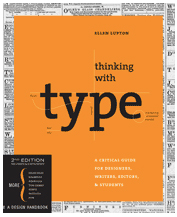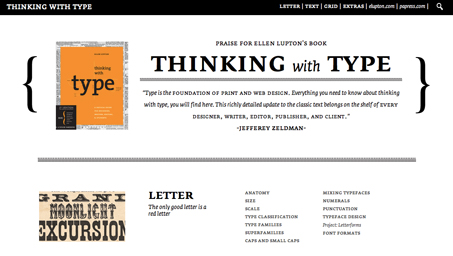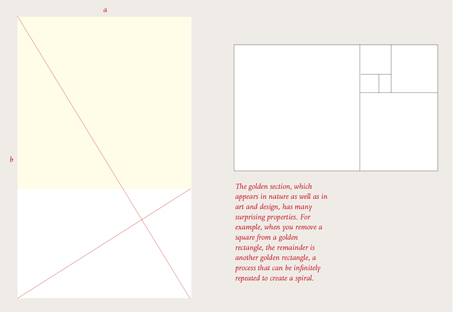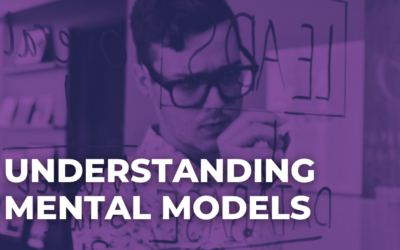Full interview of my conversation with Ellen Lupton (@EllenLupton) author of several design books, many of which you may have read or used in design school. Thinking with type is my favorite of her books and it is currently out for it’s 2nd edition release. We discussed her role as director of the Maryland Institute College of Art, MICA and Masters programs in design. I got her to talk a little bit about her opinions of web typography. I love a good design discussion and Ellen always brings it.
 Gene Crawford: Hello, and welcome to another interview on unmatchedstyle. I’m sitting here with Ellen Lupton. She is the author of lots of books in our industry, mostly this one, Thinking With Type, which is in its second edition.
Gene Crawford: Hello, and welcome to another interview on unmatchedstyle. I’m sitting here with Ellen Lupton. She is the author of lots of books in our industry, mostly this one, Thinking With Type, which is in its second edition.
Ellen Lupton: Yeah.
Gene: You’re also curator of the contemporary design at Cooper-Hewitt National Museum in New York.
Ellen: Yes, I am.
Gene: You’re also director of the MFA program at Maryland Institute of Graphic Arts, right?
Ellen: Right, Maryland Institute College of Art, MICA.
Gene: I’ve see some of you’re articles on New York Times and Fast Company and stuff. So that’s Ellen Lupton, in case you didn’t know. But I wanted to ask you, you work at Cooper-Hewitt National Museum. What do you do there? What do you do ask curator of the design section of a museum like that?
Ellen: Well Cooper-Hewitt is the only museum that’s dedicated exclusively to design, historic and contemporary. So I’m part of a team of curators up there who put together exhibitions for the public about how design impacts our life and how design is an ever evolving language and a form of art. But also, a form of art that people use. And it relates to the world we live in in a very direct way.
Gene: You also, as part of your work at the Maryland Institute College of Art, you’re also the Director at the Center of Design Thinking. What is that?
Ellen: Well, I’m director of the graduate program at MICA, and in addition to that, I head this center which creates publications. And some of the books that we do, like this one, are actually designed and produced with graduate students in my program. And so I engaged them in the process from start to finish of creating a publication that has readers in mind. These are not portfolio pieces or vanity press books. These are real books in real book stores.
Gene: Actual public consumption.
Ellen: Yup. And they really have to work as communication to an audience. And since we’re a graduate program, we believe that part of what we should do is expand the knowledge of our field. And so we do books that are directed at the general public, and also and education audience that help to explain and demonstrate principles of design.
Gene: How many books have you guys produced?
Ellen: We’re now finishing, I think our fourth one in this series created by the students.
Gene: That leads me to another question that I’ve always been curious about. In our profession, web design, there’s never really an MFA program, or a master’s program for what we do, necessarily, although there are some that are coming out. What does an MFA student face? What do they go through, briefly, through their two years of wrapping up?
Ellen: Well, all the programs are different. In my program, it’s very project oriented and very structured. So if you look at MFA programs around the country, it’s kind of a spectrum from a very structured program like mine, and a very open ended program. Say, like at Cranbrook Academy which is much more you go there as an artist and pursue your own work. And you have a mentor, but it’s pretty independent. I really believe that graphic designers like to do jobs. They really like to respond to a situation.
Gene: It is commercial design.
Ellen: It is, and that’s kind of what draws people to this field. Graphic design is practical, it’s commercial, it’s social, it’s something you do with other people. So we try to create that atmosphere in our program, especially in the first year. And in the second year, and this is typical of MFA programs, student have to define their own major independent project. A thesis project. And that can be a challenge, because, again, graphic designers are used to responding to a problem. And so we really need to teach them how to frame their own problem at that point, and how to create a project where they can use all of their ability as a designer to create some new content.
Gene: So that’s some of the work you do with your books that you publish.
Ellen: Absolutely, right.
Gene: OK. So back to your recent book, Thinking With Type, which is in its second edition. I think it’s pretty cool, because you updated it with some stuff that really impacts our industry, I think.
Ellen: Good, good.
Gene: But you stated in there that you wrote this book because you were looking for one that suited some needs, that you couldn’t find.
Ellen: Right.
Gene: I have to agree with you, until I found your book. But what made you just jump into writing your own book?
Ellen: Well, I started teaching typography some years ago. And that’s the best way to really articulate what you know is to try to teach somebody. You do that, you’re teach web design. That’s how you know what you don’t know, is you have to explain it to people.
Gene: You know pretty quick.
Ellen: And I found that there are many books about typography on the market, and some of them were too serious for my students. They were too much about the art of the book. They were very traditional and very classic. And there are some great books in that mode, like Robert Bringhurst ‘s book, The Elements of Typographic Style. Great book, but I found that my students were kind of not reading it. And on the other hand, there’s design for dummies, and I don’t like that approach either. There’s a lot of books out there that have good content and really ugly illustrations. And you really want your students to be looking at great examples of design when they’re learning about design.
So I did this book that is inexpensive. It’s not too big and heavy. It’s got a lot of information in it, but it’s not going to overwhelm you. It doesn’t have the kitchen sink. It’s like, some of the stuff you should know about typography is in this book. And if you can go through this whole book, you will have a good basic literacy of typographic practice. It’s contemporary, and it relates to a variety of media and context that type works in today.
Gene: You focused mainly on just editing it down to the bare essentials. Because you went from type to letter forms on a page, to sentences and paragraphs to grid layout.
Ellen: Yeah, the book has three main sections: letter, text, and grid. And so, letter is where you think about letter forms, and fonts, and how to choose fonts, and the parts of a typeface. And text is really about how you put letters together to create pages and screens of information. And grid is about the system that it all fits into.
Gene: Yeah, the grid system was one I kind of keyed in on. Grid design has been around a long time, it’s not new. But it’s kind of a new revolution to web design. There’s lots of new people that come to come to MetStyle that are just kind of discovering the grid. Are there any suggestions you can give someone who’s just kind of starting to “get it” in their web design?
Ellen: Well, what a grid does, is it creates structure. And it creates a coherence page after page. And that really makes users feel good when the see this consistency. And it makes your job easier because you’re not designing each page anew. You’re re-using elements. And it’s really important in web design, which is so systematic, that you’re not designing each page. You’re creating templates.
Gene: Creating a system.
Ellen: Yeah, exactly. So it is really important to have intelligent, useful elements of information. And I think we are all very familiar with column grids in the web. I think what’s harder is creating horizontal elements.
Gene: It is, yeah.
Ellen: It is tough in CSS. And so, what I like in web design I’m always really excited when I see a nice horizontal element.
Gene: That part is hard. Back to your book here, there’s lots of great pieces on it but my all time favorite part was the end where you just gave some advice. And when we talk about it a couple of this because I thought they were interesting. One of your quotes is density is any wise space. Can you sort of riff on that a little bit and tell me what you were implying?
Ellen: That is a long history in design and worshiping like big, open spaces. But there’s lot of value to packing a lot of information into a small space and especially on the web where we are dealing with smaller and smaller screens. The need to present people with a lot of information simultaneously so they can choose what they want.
Gene: Right.
Ellen: Look at a website like the newyorktimes.com. Not a lot of white space. And yet, you don’t feel overwhelmed or oppressed by it because there is my padding and space between columns and you can find your way around. I think designer can do a lot by just putting more space between the lines. Like I have of course loved the website at least a part of it.
And if you look at that website, it is so open and so inviting visually. And it’s really because there is a lot of space between the lines of the tide. And I sort of rules an elements to divide the space.
Gene: Let it breathe.
Ellen: Yeah, yeah. And those details really make that inviting to read.
Gene: OK. You have another one. It’s easier to talk than to listen. And I was like to think of when I am out like on a sales call or with one of the creative directors or whatever and they are just talking, talking. Is there anything you can tell us that just helps us like become better listeners other than shut up?
Ellen: That’s probably the white space, yeah. I mean I think this is something you have to learn as a human being. That conversation is a give and take. Teachers have to learn this that students can only take so much once they start putting their heads on the desk. They’ve had it. It’s time for a potty break. I think… I watched a lot of TV and I love the Colbert Report. But even there, it is like he’s got to break it up by having guests. It gets boring listening to him if he doesn’t break it up and he is a comedian.
Gene: And he is funny.
Ellen: Yeah. So, I feel like it is really important in all kinds of context to get other voices going, not having one person do all the talking.
Gene: Right. there’s another one, the final one. Your quote, build the discourse. And we believe in that message. We really want to talk designs as much as we can. What can we do as a community to talk about it more? What are some more things we can do?
Ellen: Well, there actually are things so much exciting about this point and time with social media and blogging and podcasts and all the revolutions and independent publishing. And I think that the Internet has encouraged a kind of community of self education that people I think especially in the web design field and all kinds of technical fields are really hungry to share their knowledge with other people. And they are doing that online but they are also doing that by gathering together. A big thing now where I live in Baltimore is they have like lectures and seminars in a bar. So, instead of thinking of, you know, you go to some formal thing at a hotel or in a college classroom, you go to a bar and hear people talk and have a beer.
So, I think there’s a lot of community going on that’s become less talking down and more just peer to peer. And, I think that’s really exciting.
Gene: So, I’ve got a couple of technical questions for you.
Ellen: Sure.
Gene: Just things that we’re interested in and I want to get your opinion on it. Do you feel like there’s a real typography revolution going on in website design?
Ellen: Well, absolutely because suddenly now we have WebFonts as a reality. It’s kind of the wild west right now and I think a lot’s going to happen over the next year in terms of which providers and which systems become the most important, the most viable and so forth. But, this is like hugely exciting. And, it’s going to be a big change. I think it’s going to require web designers to get more up to speed about fonts. You don’t want to be the kid in the candy store and suddenly it’s all these like Halloween fonts everywhere, you know?
Gene: Like “Hobo” everywhere.
Ellen: Exactly. So, a little knowledge can be a dangerous thing. But, I think the community is really ready for it. And, it’s funny, this is like the only industry I can think of where the consumer, which is us, the designers, has been wanting this product which is legal web fonts and the industry has been holding back saying you can’t have it.
Gene: Yeah.
Ellen: They’ve been taking their time and looking at piracy issues, but also looking at making sure that their fonts will look good when they’re displayed on screen and the spacing will be correct, the hinting and all that mumbo jumbo. But, I think now the industry’s ready, the typeface industry. And certainly, the designers are ready. And, it’s going to be a really exciting time.
Gene: Why do you think they’re taking their time so much, though, other than just wanting to make sure it’s right. I mean, when you go out and you look up some of the ULAs, it’s just non-existent. Like do you think this is a case that they didn’t think about it at all like five years ago when they designed the typeface?
Ellen: I think that there’s just a real assumption that it could never be done and that there would never be a safe way to embed typefaces and make them available to users. And now, it looks like there is. And, it’s not going to be perfect. And, people that really want to steal typefaces are still going to steal them and you can do that anyway. So, it does require a kind of community ethos to be respectful of the product. But, it’s just to make such a bigger market that I think in the end the typeface industry will really benefit.
Gene: Do you have any experience with any of the services on the market like a Typekit or Google stuff? Do you have an opinion on any of those things?
Ellen: Well, the new website for my book, thinkingwithtype.com, uses a typeface from Peter Belack’s website called TypoTech. And, he serves his own typefaces from his site and he really pioneered that in terms of saying he has his own fonts and he’s going to provide them, license them and serve them himself. And, we think it looks really awesome on our website. A student of mine designed the site and figured out how to get the small caps to work. And, it’s difficult, you know, because CSS isn’t really set up to recognize the subtle differences in type families. So, he did a lot with superscripts and kind of cheating the system to make it look kind of bookish.
But, it really works and it’s really beautiful.
Gene: Well, this is Ellen Lupton. Her new book, in it’s second edition is Thinking With Type. Thank you.
More on Ellen: Ellen Lupton is curator of contemporary design at Cooper-Hewitt, National Design Museum in New York City and director of the Graphic Design MFA program at Maryland Institute College of Art (MICA) in Baltimore. An author of numerous books and articles on design, she is a public-minded critic, frequent lecturer, and AIGA Gold Medalist. Read more…








Nice interview. Always nice to put a face to a name. I couldn’t find typotech (or the site’s just down at the moment) but had fun playing This Is Not Italic over at thinkingwithtype.com. Rated R was pretty funny, too.